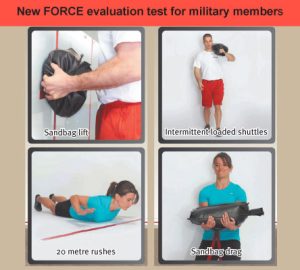Assessing fitness beyond FORCE test
By Lookout on Jun 30, 2014 with Comments 0
CF Morale and Welfare Services Directorate of Fitness has joined the push to generate a fitter and healthier military.
They are going beyond the FORCE Evaluation – the new assessment tool to determine if a member is fit for duty – and are now looking at a way to indicate a member’s general fitness level.
Researchers have been to four bases putting select members through the FORCE Evaluation to gather specific data.
Last week, 150 men and women of varying ages volunteered for the research at CFB Esquimalt
.
“We’re going across country collecting data on 600 CAF personnel to see what their fastest FORCE times are, and we’re plotting them on the incentive chart where they’ll be compared to their age and gender counterparts,” explained Dr. Tara Reilly, Research Manager Human Performance in Ottawa.
The Human Performance Research team is developing a Fitness Profile, which is a measure of fitness that goes beyond the minimums for job performance. That profile will include an incentive program that will be used to encourage members to improve both their operational and general physical fitness.
In the previous EXPRES test the incentive was an exemption on the next year’s test. However, the new motivational program is still in the development phase, so the four incentive levels and rewards have yet to be confirmed.
The new fitness profile expands on the existing FORCE Evaluation in two main ways:
- Firstly, it offers an incentive program where members will be compared to their age and gender groups in order to encourage maximal performance and improvement on the FORCE Evaluation. In this way the member will be provided with a scaled measure of his or her operational fitness compared to other people of his or her age and gender, rather than simply a pass or fail.
- Secondly, the fitness profile would provide a new metric – an assessment of a member’s overall physical fitness. This metric would be based on a measure of cardio-respiratory fitness derived from the member’s times on the intermittent loaded shuttles and the 20-metre rushes, along with a measure of body composition, with the addition of a waist circumference measure. No career action would be taken on this measure of general fitness; it would only serve to provide information and targets for improvement.
“Waist circumference is recommended by the World Health Organization and the Canadian Medical Association as being the best body composition measure for health-related physical fitness,” says Dr Reilly.
Members who go all out on the FORCE test will know exactly how they measured up against other people in their demographic. This goes well beyond the pass or fail of the test itself.
Incentivizing the program will likely push people to perform to their maximum to find out how fit they really are, says Dr. Reilly.
Personnel Support Program (PSP) fitness staff can prescribe a training program to help a member increase their fitness and meet the next incentive level. Resources to aid military members in attaining a healthier life include Health Promotion programs, dfit.ca, and personal training from PSP staff.
Carmel Ecker, Staff Writer
Filed Under: Top Stories
About the Author:






